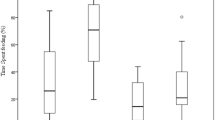Abstract
Although herbivores usually avoid plants with high concentrations of tannins, roe deer in natural habitats select tannin-rich plants. We tested the hypotheses that: (H1) roe do not seek tannins, rather they select for other (unmeasured) factors such as minerals or vitamins; and (H2) roe do select for tannins. Tame roe deer were offered a choice of food pellets to which hydrolyzable chestnut tannins had been added or control pellets. The daily consumption of pellets containing a high level of tannins (9.1%) was lower than consumption of control pellets. However, when offered medium level tannin pellets (3.8%), roe deer ate more tannin than control pellets. Moreover, the roe regulated their intake of these tannins closely. The regression of tannin intake versus total pellet intake across all the tests was linear and precise (r 2 = 0.94): intake was about 28 g of tannin per kilogram of pellets eaten. We therefore reject H1 and suggest that roe can monitor tannin concentrations in their food, and regulate their intake precisely. The results suggest that a certain level of tannins induces no costs or that they provide a nutritional benefit for roe deer.
Similar content being viewed by others
REFERENCES
Aharoni, Y., Gilboa, N., and Silanikove, N. 1998. Models of suppressive effect of tannins. Analysis of the suppressive effect of tannins on ruminal degradation by compartmental models. Anim. Feed Sci. Technol. 71:251–267.
Austin, P. J., Suchar, L. A., Robbins, C. T., and Hagerman, A. E. 1989. Tannin-binding proteins in saliva of deer and their absence in saliva of sheep and cattle. J. Chem. Ecol. 4:1335–1347.
Bernays, E. A., Cooper Driver, G., and Bilgener, M. 1989. Herbivores and plant tannins. Adv. Ecol. Res. 19:263–302.
Distel, R. A., and Provenza, F. D. 1991. Experience early in life affects voluntary intake of blackbrush by goats. J. Chem. Ecol. 17:431–450.
Drozdz, A. 1979. Seasonal intake and digestibility of natural food by roe deer. Acta Theriol. 24:137–170.
Duncan, P., Tixier, H., Hofmann, R. R., and Lechner-Doll, M. 1998. Feeding strategies and the physiology of digestion in roe deer, pp. 91-116, in R. Andersen, P. Duncan, and J. D. C. Linnell (eds). The European Roe Deer: The Biology of Success. Scandinavian University Press, Oslo.
Fickel, J., Pitra, C., Joest, B. A., and Hofmann, R. R. 1999. A novel method to evaluate the relative tannin-binding capacities of salivary proteins. Comp. Biochem. Physiol. 122:225–229.
Hagerman, A. E., and Robbins, C. T. 1993. Specificity of tannin-binding salivary proteins relative to diet selection by mammals. Can. J. Zool. 71:628–633.
Hagerman, A. E., Riedl, K. M., Jones, G. A., Sovik, K. N., Ritchard, N. T., Hartzfeld, P. W., and Riechel, T. L. 1998. High molecular weight plant polyphenolics (tannins) as biological antioxidants. J. Agric. Food Chem. 46:1887–1892.
Hodgson, J., Niezen, J. H., Montossi, F., Liu, F. Y., and Butler, B. M. 1996. Comparative studies on animal performance and parasite infestation in sheep grazing Yorkshire fog, perennial ryegrass, and tall fescue pastures. Proc. N.Z. Grassl. Assoc. 57:89–93.
Liu, F. Y., Hodgson, J., and Barry, T. N. 1998. Effects of grazing sequence and condensed tannins on ingestive behaviour, herbage intake, and performance of lambs grazing Yorkshire fog pasture. N.Z. J. Agric. Res. 41:359–366.
Robbins, C. T., Hanley, T. A., Hagerman, A. E., Hjeljord, O., Baker, D. L., Schwartz, C. C., and Mautz, W. W. 1987. Role of tannins in defending plants against ruminants: Reduction in protein availability. Ecology 68:98–107.
Robbins, C. T., Hagerman, A. E., Austin, P. J., McArthur, C., and Hanley, T. A. 1991. Variation in mammalian physiological responses to a condensed tannin and its ecological implications. J. Mammal. 72:480–486.
Schmidt, K. A., Brown, J. S., and Morgan, R. A. 1998. Plant defenses as complementary resources: a test with squirrels. Oikos 81:130–142.
Terrill, T. H., Douglas, G. B., Foote, A. G., Purchas, R. W., Wilson, G. F., and Barry, T. N. 1992. Effect of CT upon body growth, wool growth and rumen metabolism in sheep grazing sulla (Hedysarum coronarium) and perennial pasture. J. Agric. Sci. 58:312–329.
Tixier, H., Duncan, P., Scehovic, J., Yani, A., Gleizes, M., and Lila, M. 1997. Food selection by European roe deer (Capreolus capreolus): Effects of plant chemistry, and consequences for the nutritional value of their diets. J. Zool. London 242:229–245.
Waterman, P. G., and Mole, S. 1994. Analysis of phenolic plant metabolites. Blackwell Scientific Publications. Oxford, UK.
Author information
Authors and Affiliations
Rights and permissions
About this article
Cite this article
Verheyden-Tixier, H., Duncan, P. Selection for Small Amounts of Hydrolysable Tannins by a Concentrate-Selecting Mammalian Herbivore. J Chem Ecol 26, 351–358 (2000). https://doi.org/10.1023/A:1005401203954
Issue Date:
DOI: https://doi.org/10.1023/A:1005401203954




